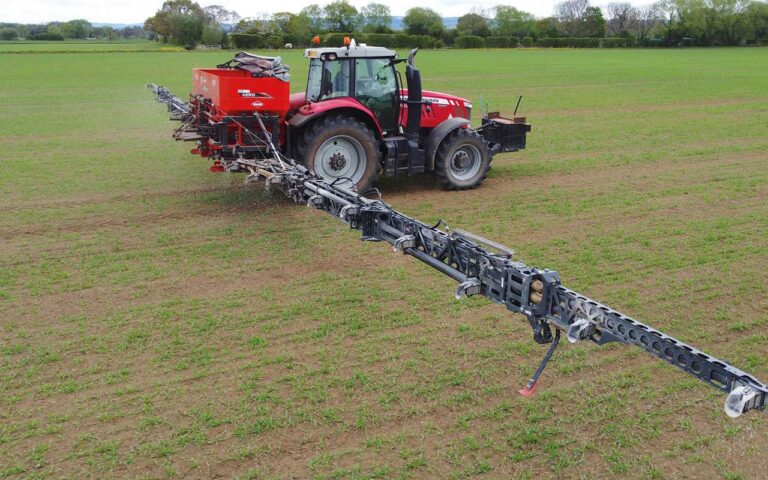Reducing losses, greater environmental protection and wider spreading windows will be the aim for every user applying granular fertiliser during the busy spring window.
While twin-disc machines are the weapon of choice for many, a growing group are turning to granular boom applicators to provide similar accuracy to liquid fertiliser and the ability to apply solid fertiliser when spinning disc machines would be stopped by the wind.
It is part of the reason why Kuhn reintroduced its mounted Aero boom spreader alongside the brand’s larger AGT trailed boom machine.
Kuhn’s latest 32.1 mounted model has 24-30m boom width options, and a considerable part of the technology and design has been brought across from the established trailed model. Users have the choice of two hopper sizes – a standard 1,900-litre and a larger 3,200-litre.
Four rates in one pass
Upgrades from the previous models sold in the UK include stronger aluminium booms, with improved suspension and break-back sections to increase longevity and benefit operator comfort. Headland ‘V’ settings, tilt adjustment and unfolding are all accessed via the CCI Isobus screen or tractor terminal.
A greater-capacity 1000rpm fan can apply fertiliser at higher rates, up to 360kg/min according to the product, while maintaining good forward speeds.
A unique feature of the Aero system is it can accurately apply four product rates in one pass, as four separate hydraulic metering systems control either five or six boom outlets, depending on the width.
This allows users to tailor inputs to soil demands based on nutrient deficiencies and apply these accurately using variable-rate input maps. Different metering rollers are also an option for growers applying small seeds, slug pellets or microgranules.
A weighing system matches application rate to forward speed and automatically adjusts on the go. The diffusers on the end of each outlet can be reversed when spreading into tall crops, and the Aero’s output is comparable to a twin-disc spreader, as the weather windows are wider, which boosts the options available to the user.
Case study
- User Patrick Swiers
- Location Sessay, North Yorkshire
- Machine 2023 Kuhn Aero 32.1
One grower who has been an advocate of boom granular spreaders is Patrick Swiers, who farms in North Yorkshire.
His latest spreader – a Kuhn Aero 32.1 – arrived in 2023 and was the first of the new generation of mounted Aero models to land in the UK. He says it gives him flexibility, not only with the products he buys, but the windows in which to apply them.

With a wide variety of fertiliser types and quality on the market, the Aero system can precisely apply a greater selection of granules than a twin-disc spreader, allowing him to choose fertiliser with a poor spreading quality, but which still maintains the right nutritional value.
The Aero has 20 outlets across the 24m boom, split into four sections, and Patrick explains why the spreader works in his system.
“I have one man who does all the spraying and granular fertiliser spreading in the spring and, invariably, the wind and rain will stop both jobs. However, by having the Aero, when the wind gets too much for spraying, he can simply spread fertiliser granules accurately over the 24m width.”
Patrick farms 400ha at Briars Hill Farm in Sessay, North Yorkshire. The farm is split across two ring-fenced sites, two miles apart, and a large percentage of hybrid rye is now grown to deal with a persistent ryegrass problem.
The rest is a mix of wheat and spring barley, with some maize grown for a local anaerobic digester plant and dairy farmer.
Flexibility to choose fertiliser
With the separate metering rollers for different products, the Aero can apply Avadex, slug pellets and even small-seed cover crops, with improved accuracy compared with small-disc hoppers on the rear of a UTV. Justification for Patrick was simple, as flexibility across his system is paramount.
“I always say the Aero offers me the flexibility of solid fertiliser, but the accuracy of liquid. I can buy any type of granular fertiliser, no matter the quality or spreadability, and know it will still be applied to the highest accuracy and in conditions where a twin-disc machine would be stopped.
“I’m also not in the hands of liquid fertiliser suppliers that are busy in the spring getting product onto farm. I can get all my fertiliser on farm over the winter and spread when I require it during the spring,” says Patrick.
In terms of the output of the Aero compared to a twin-disc machine, Patrick concludes by saying he’s been impressed with what can be achieved when fertiliser is applied to the field.
“I don’t believe we are far away from a twin-disc output. At 250kg/ha, we can achieve 80ha in an afternoon at forward speeds of 15kph, without pushing too hard.
“However, when you consider the other benefits of applying when it suits us, the application windows are much wider, so we can take our time to ensure the job is right.”



